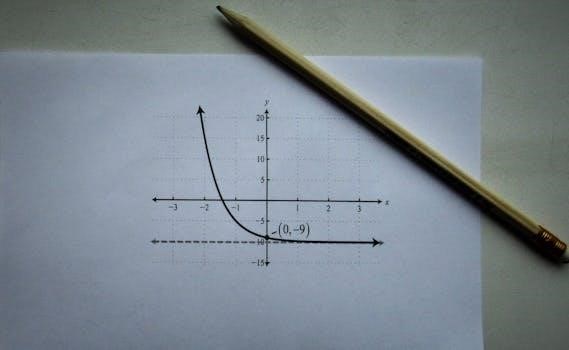Explore our comprehensive subtracting integers worksheets available in convenient PDF format, complete with answer keys․ These resources offer valuable practice for students learning to master integer subtraction․ EffortlessMath․com provides additional support and resources for excelling in mathematics․ Download and print for effective learning․
Understanding Integers
Integers are whole numbers that can be positive, negative, or zero․ They do not include fractions or decimals․ Understanding integers is fundamental in mathematics, serving as a building block for more complex concepts․ Positive integers are greater than zero, while negative integers are less than zero․ Zero is an integer that is neither positive nor negative․
Working with integers involves various operations, including addition, subtraction, multiplication, and division․ The rules for these operations can differ slightly from those for whole numbers, especially when dealing with negative integers․ For instance, subtracting a negative integer is equivalent to adding its positive counterpart․
Integers are commonly represented on a number line, where positive integers extend to the right of zero and negative integers extend to the left․ This visual representation is helpful in understanding the order and relationships between integers․ It is crucial to grasp the concept of integers before delving into operations like subtracting integers, as a solid foundation ensures accuracy and confidence in solving mathematical problems․ Recognizing and understanding integers is essential for various real-world applications, from calculating temperature changes to managing financial transactions․
The Concept of Subtraction with Integers
Subtraction with integers involves finding the difference between two integers․ Unlike subtracting whole numbers, subtracting integers requires careful attention to the signs of the numbers involved․ Understanding this concept is essential for accurately solving subtraction problems that include both positive and negative numbers․ When subtracting a positive integer, we move to the left on the number line, effectively decreasing the value․
However, when subtracting a negative integer, it is equivalent to adding its positive counterpart․ This is often described as “adding the opposite․” For example, subtracting -5 from 3 is the same as adding +5 to 3, resulting in 8․ This rule is crucial to grasp, as it simplifies the process of subtracting negative numbers and ensures correct calculations․
Visualizing subtraction with integers on a number line can be very helpful․ Start at the first integer and then move left (for subtracting a positive integer) or right (for subtracting a negative integer) by the value of the second integer․ This visual aid reinforces the concept and helps avoid common errors․ Mastering subtraction with integers is a fundamental skill that extends to various areas of mathematics, including algebra and calculus․
Rules for Subtracting Integers

When subtracting integers, it is essential to follow specific rules to ensure accuracy․ The primary rule to remember is⁚ subtracting an integer is the same as adding its opposite․ This applies to both positive and negative integers․ For instance, if you’re subtracting a positive integer, you add a negative integer with the same absolute value․ Conversely, if you’re subtracting a negative integer, you add a positive integer with the same absolute value․
To illustrate, consider the expression 5 ౼ 3․ This is equivalent to 5 + (-3), which equals 2․ Now, let’s consider 5 ⏤ (-3)․ This is equivalent to 5 + 3, which equals 8․ These examples highlight the importance of changing the subtraction operation to addition and using the opposite of the integer being subtracted․
Understanding and applying this rule is crucial for solving more complex problems involving multiple integers and mixed operations․ Remember to pay close attention to the signs of the integers and consistently apply the “add the opposite” rule to avoid errors․ Mastering this rule will significantly improve your ability to work with integers effectively․
Subtracting a Positive Integer
Subtracting a positive integer involves moving to the left on the number line․ This is because subtracting any positive value decreases the initial number․ Consider the example of 7 ⏤ 3․ Here, we start at 7 and move 3 units to the left․ This results in 4․ This principle is fundamental and applies regardless of the magnitude of the integers involved․
When working with larger numbers, envisioning the number line can still be helpful, even if you don’t draw it out completely․ For example, 25 ౼ 10 means starting at 25 and decreasing by 10, leading to 15․ The key is to recognize that subtracting a positive integer always leads to a smaller value, shifting the position towards the negative side of the number line․
In practice, subtracting a positive integer is straightforward․ Simply perform the subtraction as you would with whole numbers, ensuring you understand the direction of the operation on the number line․ This understanding builds a strong foundation for more complex integer operations․
Subtracting a Negative Integer (Adding the Opposite)
Subtracting a negative integer is equivalent to adding its opposite, a fundamental concept in integer arithmetic․ This rule simplifies calculations and enhances understanding․ When you encounter an expression like 5 ౼ (-3), it transforms into 5 + 3, resulting in 8․ This transformation is crucial because subtracting a negative number effectively moves you to the right on the number line, increasing the value․
Consider another example⁚ -2 ⏤ (-7)․ Applying the rule, we change this to -2 + 7, which equals 5․ The negative sign in front of the 7 is negated, changing the operation from subtraction to addition․ This principle holds true for all integer subtractions involving negative numbers․
Understanding this concept is vital for solving more complex problems․ For instance, in algebraic expressions, subtracting a negative term is the same as adding a positive term․ This rule not only simplifies calculations but also reinforces the relationship between addition and subtraction in the context of integers․ Mastering this technique is crucial for further studies in mathematics․
Number Line Visualization for Integer Subtraction
Visualizing integer subtraction on a number line offers a powerful way to understand and perform these operations․ When subtracting a positive integer, move to the left on the number line․ For example, to solve 5 ౼ 3, start at 5 and move 3 units to the left, landing on 2․
Conversely, when subtracting a negative integer, move to the right on the number line․ This is because subtracting a negative number is the same as adding its positive counterpart․ To solve 2 ౼ (-4), start at 2 and move 4 units to the right, landing on 6․
The number line provides a clear visual representation of how values change during subtraction․ It helps to solidify the concept that subtracting a negative number increases the value, while subtracting a positive number decreases it․ This method is particularly useful for students who are new to integer operations, as it provides a concrete way to understand abstract mathematical concepts․ Practice with number line visualizations can significantly improve proficiency in integer subtraction․
Worksheet Examples and Practice Problems
Our subtracting integers worksheets feature a variety of examples and practice problems to reinforce understanding․ These problems range in difficulty, starting with simple subtractions involving small integers and progressing to more complex problems with larger and mixed integers․ For instance, students might encounter problems like 5 ౼ 8, -3 ⏤ 2, or 7 ⏤ (-4)․
The worksheets also include horizontal subtraction problems, which require students to arrange the integers and perform the operation correctly․ Additionally, some problems are presented in a fill-in-the-blank format, challenging students to find the missing integer in a subtraction equation; Word problems are included to provide real-world context and enhance problem-solving skills․
These practice problems are designed to build fluency and confidence in subtracting integers․ The worksheets are available in PDF format, making them easy to print and use in the classroom or at home․ Answer keys are provided to allow students to check their work and identify areas where they may need additional practice․ Regular practice with these worksheets will help students master the concept of subtracting integers․
Free Printable PDF Worksheets
Access a wide array of free printable PDF worksheets designed to help students master the subtraction of integers․ These worksheets are readily available for download, providing a convenient and cost-effective way to reinforce learning both in the classroom and at home․ The worksheets cover a range of skill levels, ensuring that there are suitable exercises for students of varying abilities․
Each worksheet is carefully crafted to provide ample practice opportunities, with a variety of problem types to keep students engaged․ From basic subtraction problems with small integers to more challenging exercises involving larger numbers and mixed signs, these worksheets offer a comprehensive approach to learning integer subtraction․ The PDF format ensures that the worksheets are easily printable and maintain their formatting, making them ideal for repeated use․
These free resources are an excellent tool for teachers looking to supplement their lesson plans and provide additional practice for their students․ Parents can also use these worksheets to support their children’s learning at home, helping them to build confidence and fluency in subtracting integers․
Answer Keys and Solutions

Comprehensive answer keys and detailed solutions are provided alongside our subtracting integers worksheets in PDF format․ These resources are designed to support educators and learners alike, enabling efficient assessment and a deeper understanding of the concepts․ Each worksheet comes with a corresponding answer key, ensuring quick and easy grading for teachers and immediate feedback for students․
The solutions provided go beyond just the answers; they often include step-by-step explanations of how to arrive at the correct solution․ This is particularly helpful for students who may be struggling with the material, as they can follow the reasoning behind each step and identify any errors in their own approach․ The availability of these detailed solutions promotes self-learning and allows students to work independently, building confidence in their abilities․
Teachers can utilize these answer keys and solutions to identify areas where students may need additional support and tailor their instruction accordingly․ The combination of practice worksheets and detailed solutions provides a complete learning package, fostering a solid foundation in subtracting integers․
Applications of Integer Subtraction
Integer subtraction extends beyond the classroom, finding practical applications in numerous real-world scenarios․ Understanding how to subtract integers is crucial for various fields, including finance, science, and everyday problem-solving․ In finance, for example, integer subtraction is used to calculate profit and loss, track debts, and manage bank accounts․ A loss can be represented as a negative integer, and subtracting that from a positive integer (income) shows the net financial position․
In science, particularly in physics and chemistry, integer subtraction is essential for determining temperature changes, calculating energy differences, and measuring distances relative to a reference point․ For instance, if the temperature drops from 10 degrees Celsius to -5 degrees Celsius, subtracting -5 from 10 gives the temperature difference․
Everyday applications include calculating altitude changes (e․g․, hiking), keeping score in games, and even understanding time zones․ These real-world connections help students appreciate the relevance of integer subtraction and motivate them to master the skill․

Real-World Examples and Word Problems
To solidify understanding of integer subtraction, consider real-world examples and word problems․ These practical scenarios help students connect abstract concepts to tangible situations․ For example⁚ “Last night, the temperature in New York City went down to 4°F․ In Antarctica, the temperature went down to -20°F․ What is the difference in temperature between the two locations?” This problem requires subtracting -20 from 4, resulting in a difference of 24 degrees․
Another example⁚ “A football team gained 8 yards on one play but lost 5 yards on the next․ What was the net yardage gained or lost?” This involves subtracting 5 from 8, giving a net gain of 3 yards․
Word problems can also involve elevation changes, financial transactions, or even simple games․ These examples not only reinforce the rules of integer subtraction but also enhance critical thinking and problem-solving skills․ By working through these scenarios, students develop a deeper understanding of how integer subtraction is used in everyday life․

